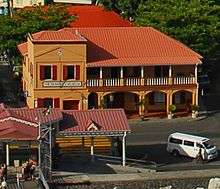The Dominica Museum

The Dominica Museum is a museum on the quay in Roseau, Dominica. It is the national museum of Dominica. It is located in a small orange (as of 2007) building, formerly an Old market building and a post office dating to 1810.[1][2][3] This building lies in the old colonial part of the city, next to the Garraway Hotel just northwest of the Fort Young Hotel, in front of the Old Market of Roseau, the centre for slave trading during colonial times.[4]
Architecture
As of 2007, the museum was painted orange, with an orange tiled roof. Common in Roseau, the window shutters are painted red/gingerbread, matching the door. The colonial building dating to 1810 is two stories high, with the Office for Tourist Information on the ground floor and the second floor containing the museum and providing views of the city from the second-floor balcony.[5] The entrance to the museum is on the left, with a bay to the side of the door and two bays above it, with a clock at the top. To the right, the main section contains four pillars on the ground floor and five pillars on the second floor. The four pillars on the ground floor each have pot plants in front of them.
Displays
Dominica's most notable historian, Lennox Honychurch, has been responsible for much of the museum.[3] The Dominica Museum contains general items related to the cultural and social history and geology and archeology of Dominica.[6] These include old photographs, photographs and portraits of past rulers, colonial furniture, including a chair and old cabinet and a barometer, specimens of birds and fishes, colonial agricultural items and indigenous cultural articles including the Pwi pwi, a miniature form of raft, a replica of a Carib hut and Arawak pottery and tools.[7][8][2] Of note are some stone axes, some of them reaching 9 inches in length.[9] The museums also contains displays related to the Volcanology of the island, and artifacts related to the early settlers also include oars, domestic implements, wooden figurines and old musical instruments.[8]
References
- ↑ Golden, Fran Wenograd; Brown, Jerry (19 November 2004). Cruise Vacations for Dummies 2005. For Dummies. p. 282. ISBN 978-0-7645-6941-8. Retrieved 25 June 2011.
- 1 2 Sullivan, Lynne M. (1 March 1999). Martinique, Guadeloupe, Dominica & St. Lucia. Hunter Publishing, Inc. p. 8. ISBN 978-1-55650-857-8. Retrieved 25 June 2011.
- 1 2 Lakeside Publishing Co. (2008). Cruise Travel. Lakeside Publishing Co. p. 10. ISSN 0199-5111. Retrieved 25 June 2011.
- ↑ Gravette, Andrew Gerald (2000). Architectural heritage of the Caribbean: an A-Z of historic buildings. Signal Books. p. 168. ISBN 978-1-902669-09-0. Retrieved 25 June 2011.
- ↑ Sullivan, Lynne M. (1 August 2004). Adventure guide to Dominica & St Lucia. Hunter Publishing, Inc. p. 50. ISBN 978-1-58843-393-0. Retrieved 25 June 2011.
- ↑ "Dominica Museum". Visit Dominica. Retrieved 22 June 2011.
- ↑ Great Britain. Colonial Office (1962). The Colonial Office list. H.M.S.O. p. 185. Retrieved 25 June 2011.
- 1 2 Dominica Museum. Dominica Island info. Retrieved 25 June 2011.
- ↑ Thirty-Fourth Annual Report of the Bureau of American Ethnology to the Secretary of the Smithsonian Institution. 1922. Retrieved 25 June 2011.
External links
Coordinates: 15°17′47″N 61°23′15″W / 15.29639°N 61.38750°W